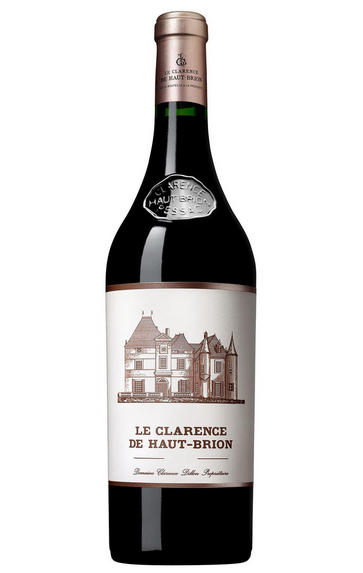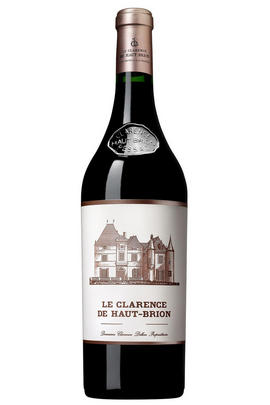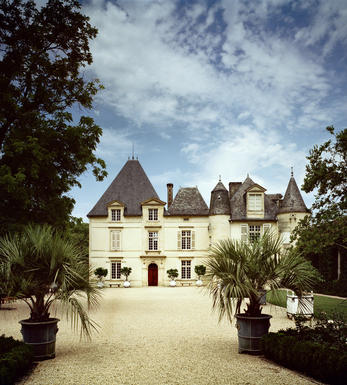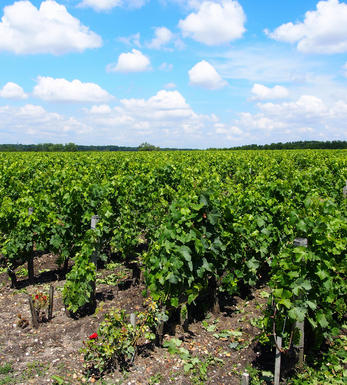
2021 Le Clarence de Haut-Brion, Pessac-Léognan, Bordeaux

Critics reviews
The 2021 Le Clarence de Haut-Brion has a very pure bouquet of blueberry, cedar and violet, perhaps slightly more ethereal than the La Chapelle de la Mission Haut-Brion. The palate is medium-bodied with quite strict tannins and a little more saline than expected, leading to a fresh finish. Maybe it lacks a bit of persistence, but it is a fine Deuxième Vin.
Drink 2026 - 2036
Neal Martin, Vinous.com (May 2022)
The 2021 Le Clarence de Haut-Brion is deep, fleshy and super-expressive. Like all of the wines in this vintage here, the Clarence is on the lighter side, but that is not a bad thing. Primary dark fruit, leather, spice and tobacco fill out the layers nicely.
There’s a ton to like in the 2021s from Haut-Brion and La Mission Haut-Brion. The reds show off the gracious side of the vintage to great effect, with lifted aromatics, silky textures and primary fruit at this early stage. It’s a terrific vintage for the whites as well, all of which are the same 55% Sémillon/45% Sauvignon Blanc blend. “Back in the 1990s, harvest dates were chosen for us by deteriorating conditions at the end of harvest. Rain and the risk of rot essentially dictated when the fruit had to come in,” Managing Director Jean-Philippe Delmas told me. “In the 2000s, with climate change, we were forced to the other extreme, that is to say picking earlier and earlier to avoid losing acidity and bringing in overripe grapes. Two thousand twenty-one was a very rare vintage in which we could harvest when we wanted to, with no pressure whatsoever.”
Drink 2025 - 2033
Antonio Galloni, Vinous.com (May 2022)
Bright and vibrant ruby and violet in colour, and even with higher levels of Merlot in the blend this year, this is more structured and subdued than the Chapelle with the character diffrence between the two estates fairly marked. Has a feeling of solidity and depth, with a focus on black fruits and tight tannins, give it a good four or five years before opening. 28% new oak.
Drink 2025 - 2038
Jane Anson, JaneAnson.com (May 2022)
Fragrant red-fruit notes. Broad and smooth on attack with finely integrated tannins. Palate a bit more subdued but fresh with firmness on the finish. Room for development.
Drink 2026 - 2036
James Lawther, JancisRobinson.com (May 2022)
More closed and shy than La Chapelle de la Mission Haut-Brion, the 2021 Le Clarence de Haut-Brion offers up a delicate, complex bouquet with aromas of plums, spices, lead pencil, licorice and dark berries. Medium to full-bodied with a structuring core of fruit, it’s seamless and vibrant with a long, penetrating finish. Keep it over the next decade.
Drink 2024 - 2034
William Kelley, Wine Advocate (February 2024)
70.4% Merlot, 18.2% Cabernet Sauvignon and 11.4% Cabernet Franc.
Lots of iodine and oyster-shell aromas, together with blackberry and black cherry, following through to a medium to full body. Polished yet slightly chewy tannins and a fresh finish. Grilled orange.
James Suckling, JamesSuckling.com (May 2022)
Dark chocolate and red cherries on the nose, so aromatic, rich and seductive. Joyful and lifted on the palate, strawberries and plums to the fore but creamy and chalky with such sappy, agile and lively energy. Lightly framed so you get the aerial expansion of flavour but the texture that grips is chalky and mineral giving a welcome salinity and touch of tobacco and smoke that lands on the tongue. Beautifully presented, smooth and well defined, such succulence and density with no let up through the palate. Intensity, clarity and focus. An excellent second wine in 2021.
Drink 2025 - 2045
Georgina Hindle, Decanter.com (April 2022)
The 2021 Le Clarence De Haut-Brion is a slightly darker, richer wine with lots of black cherries, scorched earth, and graphite notes as well as medium to full-bodied richness and depth on the palate. Balanced, elegant, and seamless, it's certainly a beautiful wine and as well as a terrific introduction to this château.
Drink 2018 - 2038
Jeb Dunnuck, JebDunnuck.com (June 2022)
About this WINE

Chateau Haut-Brion
The only property from outside the Médoc to be included in the 1855 Classification, Haut-Brion’s viticultural history can be traced back further than its Médoc First Growth counterparts. Samuel Pepys even mentions it in his diaries. Situated in what is now Pessac-Léognan, the property finds itself now in the suburbs of the ever-encroaching city of Bordeaux.
After falling into a state of disrepair the estate was purchased in 1935 by Clarence Dillon, an American financier, since when it has enjoyed a steady and continual resurgence to a position of pre-eminence. Dillon’s great-grandson, Prince Robert of Luxembourg, now runs the estate, but a key influence in the reputation which Haut-Brion enjoys today is the Delmas family. George Delmas was manager and wine-maker until 1960, when his son Jean-Bernard took over. Jean- Bernard was a visionary figure, responsible for a number of important innovations, and on his retirement in 2003 his son Jean-Philippe took over as Directeur Générale.
The vineyard is planted to 40% Cabernet Sauvignon, 37% Merlot and 18% Cabernet Franc. A stunning white wine is also made, from a part of the vineyard which is 63% Semillon and 37% Sauvignon Blanc. Production is smaller than at the other First Growth Wines, totalling about 20,000 cases, shared between the Grand Vin and a second wine, formerly called Bahans-Haut-Brion but changed in 2007 to Clarence de Haut-Brion in recognition of Clarence Dillon. Production of Haut Brion Blanc is minute, less than 800 cases in most years.
Beginning with the 2009 vintage a new white wine was introduced in the place of Clarence: La Clarté de Haut-Brion, the offspring of Domaine Clarence Dillon's two prestigious white wines: Château Haut-Brion Blanc and Château La Mission Haut-Brion Blanc.
Fermentation of the red wines takes place in stainless steel vats, after which the wine will spend 22 months, sometimes more, in new oak barrels before being bottled unfiltered. For the white wine fermentation takes place in new oak barrels, after which the wine spends a further year to 15 months on its lees in barrel before bottling. The white wine is truly sensational, equivalent in class to a top-flight White Burgundy Grand Cru, but its scarcity means that it is rarely seen.
The red wine is no less extraordinary; at its best it displays text-book Graves characteristics of cigar-box, curranty fruit, earth, smoky spice and cassis. The high Merlot content, compared to the Médoc First Growths, gives it a voluptuous edge, but does not in any way detract from its ability to age.

Pessac-Leognan
In 1986 a new communal district was created within Graves, in Bordeaux, based on the districts of Pessac and Léognan, the first of which lies within the suburbs of the city. Essentially this came about through pressure from Pessac-Léognan vignerons, who wished to disassociate themselves from growers with predominately sandy soils further south in Graves.
Pessac-Léognan has the best soils of the region, very similar to those of the Médoc, although the depth of gravel is more variable, and contains all the classed growths of the region. Some of its great names, including Ch. Haut-Brion, even sit serenely and resolutely in Bordeaux's southern urban sprawl.
The climate is milder than to the north of the city and the harvest can occur up to two weeks earlier. This gives the best wines a heady, rich and almost savoury character, laced with notes of tobacco, spice and leather. Further south, the soil is sandier with more clay, and the wines are lighter, fruity and suitable for earlier drinking.
Recommended Châteaux: Ch. Haut-Brion, Ch. la Mission Haut-Brion, Ch. Pape Clément, Ch Haut-Bailly, Domaine de Chevalier, Ch. Larrivet-Haut-Brion, Ch. Carmes Haut-Brion, Ch. La Garde, Villa Bel-Air.

Merlot/Cabernet Franc
Merlot and Cabernet Franc are grape varieties commonly used in Bordeaux-style blends, particularly in the Bordeaux region of France. When these two grapes are blended, they can create a wine that combines the best characteristics of each variety.
Merlot is known for its smoothness, soft tannins, and ripe fruit flavours. It often contributes black cherry, plum, and chocolate flavours to the blend. The grapes are relatively easy to grow and ripen earlier than other Bordeaux varieties, making them versatile for blending.
Cabernet Franc, on the other hand, adds structure, depth, and complexity to the blend. It typically brings aromas of red fruits such as raspberry and strawberry, along with herbal notes like bell pepper and tobacco. These grapes have thinner skins and can be more challenging to cultivate, requiring specific growing conditions to reach their full potential.
When Merlot and Cabernet Franc are combined, the result is a well-balanced wine with various flavours and aromas. The blend often exhibits a Bordeaux wine's medium to full body, along with a smooth texture and moderate tannins. The specific flavour profile can vary depending on the proportions of each grape in the blend and the terroir and winemaking techniques employed.


Buying options
Add to wishlist
Description
Merlot 71%, Cabernet Sauvignon 11%, Cabernet Franc 11%.
A stricter selection for the grand vin has given Le Clarence de Haut-Brion a little pep; this is one of the more successful second wines of 2021. The wine has a softer, rounder texture than the grand vin, although the vintage’s trademark tannins still assert themselves on the finish. But it feels as though the remaining time in barrel will polish everything nicely. This is a well-poised wine with more quality and complexity coming down the track.
Drink 2025 - 2038
Our score: 16.5/20
Berry Bros. & Rudd
wine at a glance
Delivery and quality guarantee